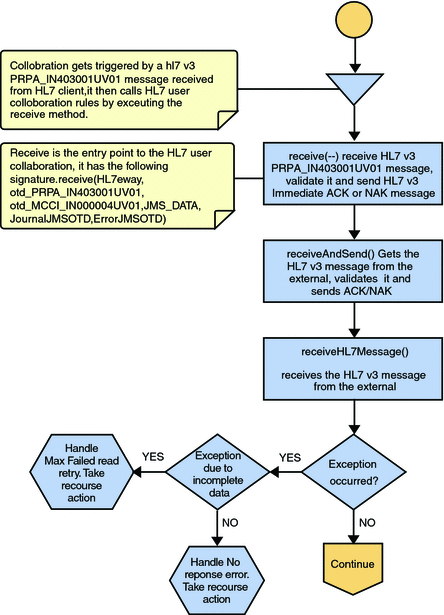HL7 V3 Standard Inbound Message Mode Data Flow (For Immediate Mode of ACK Process) — Part 1
A HL7 V3 message triggers an inbound Collaboration received from an external system or an outbound HL7 V3 Client. Execute the following Collaboration calls of the HL7 V3 User Collaboration Rule receive().
The receive method is the entry point to the HL7 V3 User Collaboration, with the following signature:
public void
receive(com.stc.connector.appconn.tcpip.hl7.HL7ServerApplication input,
com.stc.connectors.jms.JMS otdJMS_DATA,
xsd.hl7v3.PRPA_IN403001UV01.PRPA_IN403001UV01_ otd_PRPA_IN403001UV01_1
xsd.hl7v3.MCCI_IN000004UV01.MCCI_IN000004UV01_ otd_MCCI_IN000004UV01
otdHL7_ACK_1,com.stc.connectors.jms.JMS otdJMS_JOURNAL,
com.stc.connectors.jms.JMS otdJMS_ERROR) throws Throwable.
Figure 1–19 Immediate Mode of ACK Process — Part 1

Once the message is received, the Collaboration determines whether the message needs to be validated. The HL7 V3 message is then validated, making sure that the message structure is correct. Various fields in the Transmission Wrapper of the message are also validated, such as Version Code, Processing Code, Processing Mode Code, and Interaction ID. If these fields do not match the configuration, a NAK is returned.
The Collaboration receives the HL7 V3 message from the external using receiveHL7Message(). If an exception occurs due to incomplete data, and the adapter fails to read the data within the configured number of retries, the associated recourse action is taken. If the exception is due to no response, the associated recourse action is taken.
- © 2010, Oracle Corporation and/or its affiliates
